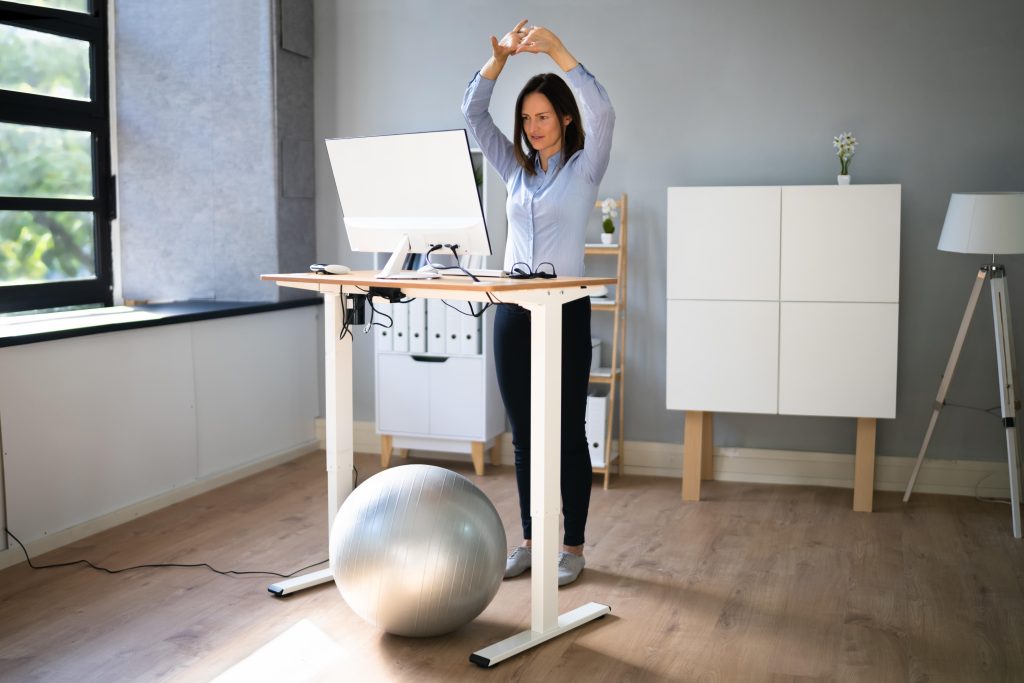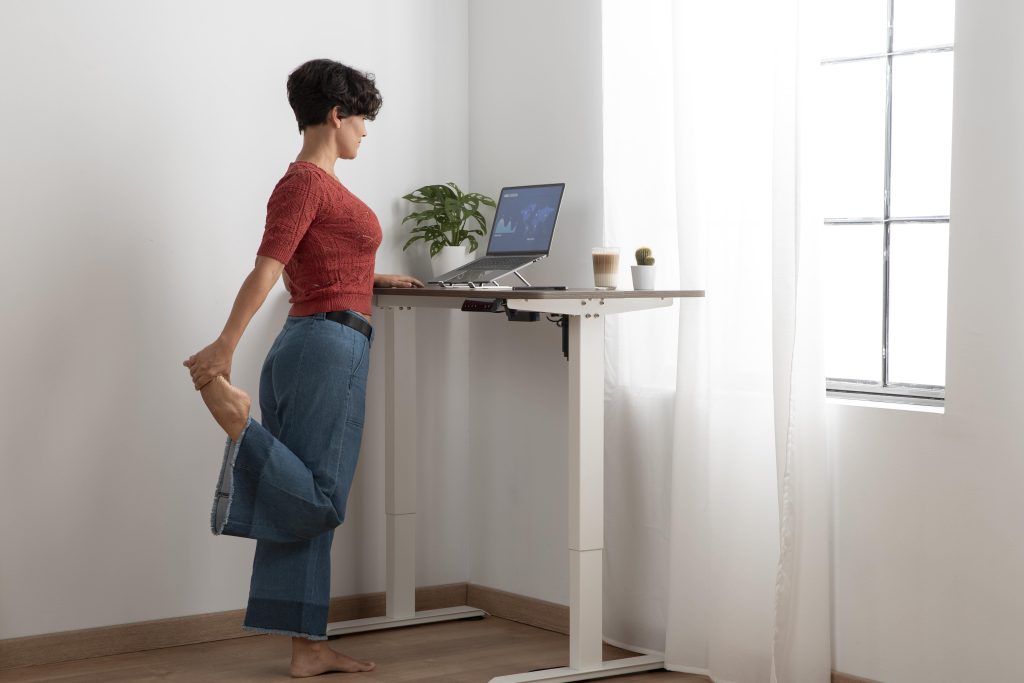
Prolonged sitting affects circulation, posture, and overall energy levels. Switching to a standing desk is a great first step, but to unlock its full potential, you need a structured standing desk workout routine. Research from the Cleveland Clinic shows that short bouts of movement—even under 10 minutes—can significantly improve physical and mental performance during the workday.
This guide gives you a complete, evidence-based system to stay active without leaving your workstation.
Even with standing desks, holding one posture for too long can lead to fatigue, tight hips, neck strain, and lower-back discomfort. A good standing desk workout solves this by:
You don’t need gym clothes, equipment, or privacy. These movements fit directly into your workflow.
Stand with your feet hip width apart.
Your body is now ready for the standing desk workout.
Calf raises activate the lower legs and improve circulation during long work sessions. Stand tall with your feet shoulder width apart and lightly place your hands on the desk for balance. Slowly raise your heels, pause at the top, then return to the starting position. Repeat for 15–20 reps at a controlled pace.
This variation engages your chest, shoulders, and core without needing to get on the floor. Place your hands on the desk slightly wider than shoulder width, step back, and lower your chest. Push away while keeping your body straight and your core engaged. Aim for 10–15 reps.
Mini squats strengthen your glutes and quads while reducing stiffness from prolonged standing. With your feet shoulder width apart, push your hips back into a light squatting position as if tapping a chair. Rise slowly and repeat for 12–15 reps while maintaining an upright chest.
Side leg lifts improve hip stability and help counteract the effects of prolonged sitting. Shift your weight to one side and lift your opposite leg outward without leaning your torso. Lower with control and repeat 12 reps on each side.
Back extensions relieve lower-back tension by reversing the typical forward posture from office work. Place your hands on your lower back, gently arch backward, hold briefly, and return. Perform 8–10 slow reps.
This movement loosens your spine and improves mid-back mobility. Extend your arms forward and twist your torso from side to side while keeping your hips facing forward. Repeat 10 times per side, breathing smoothly throughout the movement.
Seated leg extensions strengthen your quadriceps and help reduce knee stiffness. Sit tall, extend one leg until almost straight, and hold for a second. Lower with control and repeat on the other side. Aim for 10–12 reps per leg.
The desk plank builds core stability at a lower intensity than floor planks. Place your forearms or hands on the desk, step back into a straight-line position, and hold while engaging your core. Maintain the position for 20–30 seconds.
Tight hip flexors are a common result of prolonged sitting. Step one foot back into a lunge position and gently shift your weight forward until you feel a stretch at the front of your hip. Hold for 15–20 seconds and switch sides.
Arm circles help warm up your shoulders and improve mobility. Extend your arms fully and draw small forward circles, gradually increasing the size. Repeat for 20 circles, then reverse the direction for another 20.

| Minute | Exercise |
|---|---|
| 1 | Calf Raises + March in Place |
| 2 | Mini Squats |
| 3 | Desk Push-ups + Arm Circles |
| 4 | Standing Side Leg Lifts |
| 5 | Torso Twists + Light Stretch |
Do this block 1–2 times daily to dramatically improve mobility and energy.
Small moves (3 squats, 10 calf raises) keep your joints loose.
Associate actions with cues:
Low-impact cardio while reading emails.
Improves ankle mobility & core activation while standing.
For upper-body pulling exercises and posture resets.
For quick release of tight calves, quads, or lats.
Tilt head toward shoulder; hold 10 seconds.
Hinge at hips, reach downward, relax back muscles.
Cross ankle onto opposite thigh and sit back slightly.
Hands on knees, arch and round your spine gently.

| Exercise | Target Area | Duration/Reps | Notes |
|---|---|---|---|
| Calf Raises | Lower legs | 15–20 | Raise your heels slowly |
| Desk Push | Chest, core | 10–15 | Engage core |
| Mini Squat | Legs, glutes | 12–15 | Keep chest up |
| Side Leg Lifts | Hips | 12 each side | Control the lowering |
| Seated Leg Extensions | Quads | 10–12 | Avoid locking knees |
| Torso Twist | Spine | 10 per side | Hips stay still |
| Back Extensions | Lower back | 8–10 | Move gently |
| Arm Circles | Shoulders | 20+20 | Extend your arms fully |
Can I really exercise at a standing desk?
Yes. Most movements in a standing desk workout are low-impact and require minimal space.
Do I need special equipment?
No. Your body weight is enough. Equipment only enhances variety.
How often should I do a standing desk workout?
1–2 small blocks every workday are ideal.
Will this help with back and shoulder pain?
Most people experience improvement within 1–2 weeks due to increased mobility and core stability.
Does a standing desk workout count as real exercise?
It improves flexibility, strength and posture—but it does not replace gym training. It complements it.
A consistent standing desk workout routine boosts posture, reduces stiffness and keeps energy levels high throughout your day. By integrating simple movements, micro-breaks and ergonomic adjustments, you can transform your workstation into a healthier, more active environment. Start with the 5-minute block, expand into the full routine and enjoy the long-term benefits.
